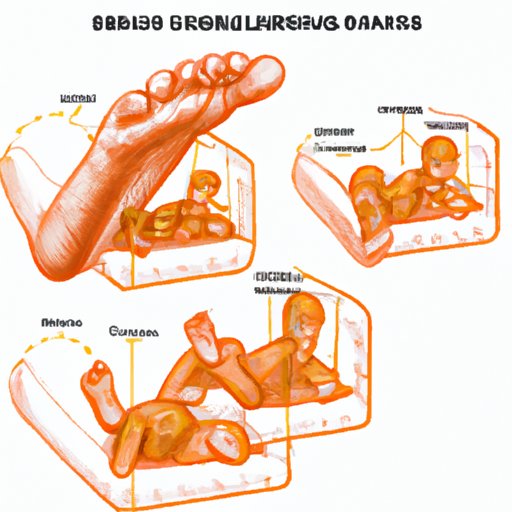Introduction
Kicking is a normal part of pregnancy, and new mothers are often curious about why their babies kick and whether it’s a sign of good health. Fetal movements can provide important clues about fetal development and well-being, and understanding the science behind fetal movement can help mothers enjoy a healthier pregnancy. In this article, we will explore the science and benefits of fetal movement and debunk common myths about the topic.

Exploring the Science behind Baby Kicks in the Womb
Fetal movement refers to the spontaneous and rhythmic movement of a developing fetus in the mother’s womb. It is one of the earliest signs of fetal development, and it can be observed on ultrasound as early as the eighth week of gestation. As the fetus grows and develops, fetal movement increases in frequency and intensity.
Babies are able to move within the womb because the uterus is filled with amniotic fluid, which provides a cushion for the fetus to move around in. The fetus is suspended in the fluid, which helps protect it from external pressure and shock. Additionally, the fetus has a highly developed nervous system that allows it to coordinate and control its movements, even in the relatively cramped environment of the womb.
Several factors can affect fetal movement, including gestational age, maternal health, and fetal position. In general, fetal movement tends to increase until about 32 weeks of gestation, after which it may plateau or decrease slightly. Maternal health can also play a role in fetal movement, as certain illnesses or medications can affect fetal development and movement.
The Benefits of Baby Kicking in the Womb for Fetal Development
Fetal movement is important for fetal development, and it can promote growth and development in different organs and systems. For example, fetal movement can help strengthen the fetal bones and muscles, and it can stimulate the development of the nervous system and brain. Additionally, fetal movement is a sign of a healthy pregnancy, and it can be reassuring for mothers to feel their babies moving and kicking inside them.
Research studies have shown that fetal movement can have positive effects on fetal health, such as reducing the risk of stillbirth and promoting good fetal circulation. For example, one study found that mothers who reported reduced fetal movements had a higher risk of stillbirth than mothers who reported regular fetal movements.
Understanding the Relationship between a Mother’s Movements and Baby Kicks
A mother’s activities and movements can stimulate fetal movement, and certain triggers are known to be associated with fetal movement. For example, eating a meal or drinking a cold beverage can sometimes cause a baby to start moving, as can changing positions or engaging in physical activity. Conversely, maternal stress or illness can sometimes decrease fetal movement, especially if the mother is dehydrated or has an infection.
Common Myths about Baby Kicks in the Womb Debunked
There are several common misconceptions about fetal movement, and debunking these myths can help mothers better understand fetal movement and avoid unnecessary worry. For example, some people believe that babies only kick when they’re hungry or awake, but in reality, fetal movements can occur at any time of day or night, and they are not always related to hunger or wakefulness.
Other myths include the idea that fetal movements should be regular and predictable, or that a decrease in fetal movements is always a cause for concern. While it is true that sudden changes in fetal movement patterns can sometimes be a warning sign of potential problems, it is also important to remember that fetal movements can vary from day to day and from hour to hour. Additionally, some babies may be more active than others, and some mothers may feel their babies moving less frequently due to differences in fetal position or maternal anatomy.
How to Monitor and Keep Track of Baby Kicks during Pregnancy
The kick count method is a simple and effective way to monitor fetal movement and ensure a healthy pregnancy. To use this method, mothers should choose a designated time of day when their baby is most active (usually in the evening), and count how many times their baby kicks or moves within a one-hour period. Mothers can use tools or apps to help keep track of their baby’s movements, and they should consult their doctor if they notice any sudden changes in fetal movement patterns.
Potential Complications When a Baby Stops Kicking in the Womb
A lack of fetal movement can sometimes be a warning sign of potential problems, and mothers should seek medical attention if they are concerned about their baby’s movement patterns. Conditions such as fetal distress, growth restriction, or placental issues can all affect fetal movement, and early detection and treatment are key to ensuring a safe and healthy pregnancy outcome.
Tips for Soothing a Baby Who is Constantly Kicking in the Womb
While fetal movement is a sign of healthy fetal development, some mothers may find excessive fetal movement uncomfortable or anxiety-inducing. To soothe a baby who is constantly kicking in the womb, mothers can try engaging in calming activities such as taking a warm bath or practicing relaxation techniques like deep breathing or mindfulness meditation. Additionally, changing positions or gently massaging the mother’s belly can sometimes help calm down an active baby.
Conclusion
Fetal movement is a normal and important part of pregnancy, and understanding the science and benefits of fetal movement can help mothers enjoy a healthier and more comfortable pregnancy. By monitoring fetal movement patterns and seeking medical attention for any concerns or sudden changes, mothers can help ensure a safe and healthy pregnancy outcome and bond with their babies before they are born.
